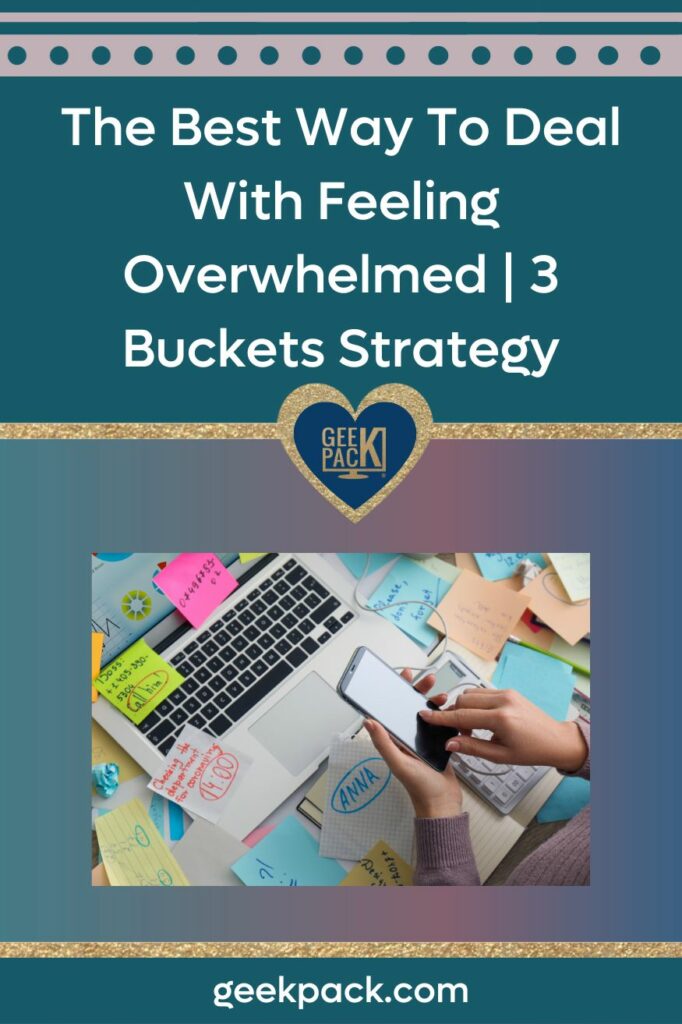
Juggling personal, professional, and social responsibilities can often leave us feeling like we're drowning in a sea of tasks.
Overwhelm becomes part of your day, making it almost impossible to figure out where to even begin. And this is not a good sign!
This is why in this blog post I want to talk about a simple, but effective strategy that can help you change that and actually learn how to prioritize.
I want to talk to you about the three buckets strategy.
A strategy I learned with my amazing coach Julie from Funnel Gorgeous. And one that has worked really well for me.
We've all been there: staring at a mile-long to-do list and feeling completely paralyzed by the huge volume of tasks ahead.
Procrastination sets in, and suddenly, taking the dog for a walk or watching a random YouTube video becomes the top priority.
Sound familiar? Because it sure does to me!

To-do lists are a popular method of task management, and while they can work great for some people or certain situations, they often fall short because:
And these are what the three buckets strategy tackles…
It's a method I've implemented in my routine and that’s made a great difference.
It helps you decide where to start by putting your tasks in three different buckets:
This is your rapid-fire zone.
Tasks in this bucket are straightforward, check-off-the-list types. Think of tasks that take no more than 20 minutes.
If you can delegate them to someone else, even better!
Example: Posting on social media
This bucket is for the heavy hitters.
These are tasks that require your undivided attention, problem-solving skills, and perhaps collaboration.
They're not quick fixes but are things you have to do. Limit these to 2 to 3 core tasks that will significantly impact your work.
Example: Crafting a presentation for a local event
Everything that doesn't fit in the first two buckets lands here.
It doesn't mean they're unimportant, but they can wait.
By giving yourself permission to set them aside, you free up mental space to focus on the more pressing tasks.
This strategy isn't just a fancier to-do list.
It’s a model that will truly reduce your overwhelm on a daily basis, without getting stuck not knowing what you should do next.
It gives you clarity so you can clearly distinguish what needs to be tackled now and what can wait.
It’s efficient! By categorizing tasks, you save time deciding what to do next.
It really helps with your stress levels, as knowing you've intentionally set tasks aside (in the Ignore bucket) frees up your list and reduces anxiety.
The amazing thing about this is that you can literally get started right now.
It’s a very simple and straightforward process to put into action!
Just go through these two steps, and it’s done! Quick and painless.
Step 1: Grab a sheet of paper or open your preferred digital note-taking tool.
Step 2: List down your tasks and categorize them into one of the three buckets.
You'll instantly get clarity on what you can tackle quickly, what demands your attention now, and what can be postponed.

There are so many time management strategies out there, and you can totally combine or tweak them to find something that works for you.
Because everyone is different, it’s impossible to have a one-size-fits-all approach to time. So here are a few other strategies that you may find interesting.
The Pomodoro Technique is a time management method that breaks work into short, focused intervals (typically 25 minutes), known as "Pomodoros," followed by a short break.
This method is particularly effective for tasks in the "Deal With" bucket because these tasks are often quick, actionable items that can pile up.
By setting a timer and dedicating a 'Pomodoro' to tackling them, you not only maintain focus but also give yourself a sense of accomplishment with each completed interval.
Time blocking is all about dedicating specific chunks of time to specific activities.
Instead of floating through the day with a vague idea of what needs to be done, you allocate strict time slots for tasks - and this can work really well especially with the "Negotiate" bucket.
These are tasks that require deep concentration and undivided attention. By blocking out time specifically for them, you ensure they get the focus they deserve, minimizing distractions and maximizing productivity.
Originating from David Allen's "Getting Things Done" methodology, the Two-Minute Rule is beautifully simple: If a task takes less than two minutes to complete, do it immediately.
This prevents small tasks from becoming big mental burdens.
Perfect for the "Deal With" bucket.
Do you know those quick emails you need to send or the document you have to print?
If they can be done in two minutes or less, tackle them right away. It's a quick win, and it reduces the mental load of having pending tasks.
When we're overwhelmed, it's often because we're unable to distinguish between what's essential and what's merely desirable.
Especially if you’re like me, and have a new idea every 30 minutes!
Creating a "Must-Have vs Nice-to-Have" list helps in prioritizing things based on their urgency and importance.
"Must-Haves" are non-negotiables - things that need immediate attention or have significant consequences if delayed.
"Nice-to-Haves," on the other hand, are exactly that, things that would be nice to have. Yes, they’d be beneficial, but they can be postponed.
By categorizing tasks this way, you get a clearer picture of where your immediate focus should be, ensuring that crucial tasks don't get lost.

And of course, I don’t want you to go ahead and try all of these at once - that would only add to your overwhelm.
But choose one or two that you related with the most, and give it a go!
Because it's one thing to know about these strategies and another to actually apply one of them consistently.
So here are some tips:
I've personally tested the Three Buckets Strategy and found it incredibly effective.
By prioritizing tasks, I've been able to hone in on what genuinely needs my attention, while also ensuring I don't spread myself too thin.


Hope this article was helpful and I’d love to hear your thoughts on time management.
Join our FREE Facebook Community and let me know!



148 Discovery Call Questions you can use to mix & match the perfect profitable call!



Copyright © 2021 - 2025 GeekPack, Inc| All Rights Reserved | Design by Soul Alchemy Branding![]() | Built by GeekPack®
| Built by GeekPack® Privacy Policy | Terms & Conditions | Earnings & Affiliate Disclaimers | Refund Policy | Sitemap
Privacy Policy | Terms & Conditions | Earnings & Affiliate Disclaimers | Refund Policy | Sitemap